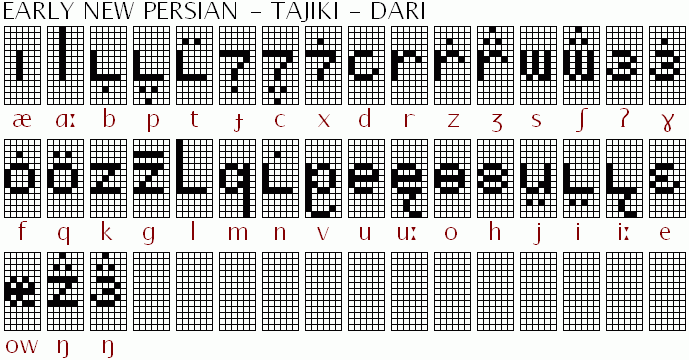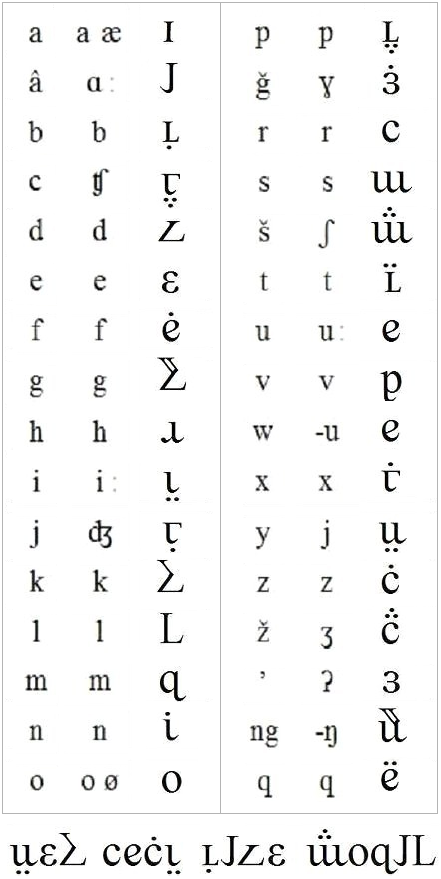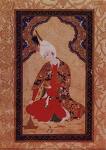1 Script encoding & identity
See the introduction on the main Bostani page for a discussion of motivation and user requirements. The current page has ideas and images from our ‘sketchbooks’ for the actual letter-forms.
2 The Rapid Evolution of Bostani
2.1 Irani heritage
One suggestion was to dispense with both the Roman and Arabic systems, and use a system more closely allied with Farsi and the Iranian culture. Might it be possible to revisit the ancient Pahlavi or Avestan alphabets, for example? Avestan was a beautiful Iranian invention, which could provide inspiration at least. Avestan is written right-to-left and has unambiguous encoding of phonemes, although many of these phonemes are not sounded in Farsi. Here is a chart of slightly stylized Avestan by Mattias Persson:

2.2 Perso-arabic elements
In the event that Persians would find Avestan writing too difficult to learn, or too alien in appearance—despite its historical standing—it might be possible to incorporate some Perso-arabic letterforms or style. For example, the diacritic dots of Perso-arabic letters are distinctive; in particular, the triple-dots of Persian are very attractive. And stylistically, the common Avestan /a/ and /a:/ are similar to a series of Perso-arabic dot holders. Avestan and Perso-arabic share many basic strokes, although in Avestan letters are not joined. In any case, since the parent of both Avestan and Arabic scripts is Aramaic, some correspondences are inevitable.
2.3 Left to right
The underlying encoding might run left-to-right, so we would have { f â r s i } instead of { i s r â f } as it was in the Perso-arabic stream. In this event, the script would naturally go the same way; for a design based on Perso-arabic or Avestan, this would involve mirroring. Here is a preliminary chart of relevant letter forms, showing UniPers and IPA transliteration, with Pahlavi, Psalter, Avestan, and Perso-arabic letters:


The images of Pahlavi and Psalter letters come from
Omniglot.
The Avestan letters come from my
Avestan script page.
*in UniPers the letter q is used for both Ghain and Qaf, but here we have introduced ğ (G with Breve) to hold the value of Ghain, keeping q for the value of Qaf. In Tehrani Persian they are pronounced the same, but in some dialects and both the important Dari and Tajiki variants, the distinction still exists.
2.4 Stylization
A stylized, unjoined, left-to-right version of Perso-arabic is attempted, as an interim stage. Mattias uses an LCD approach for this, while I use modified Times New Roman letters. We have also included a letter for the velar nasal, which is not officially part of the Farsi phonology but is heard in final position as /ng/:


This sample reads /yek ruzi bâd-e shomâl/ “One day the north wind”.
2.5 Further development
Relevant letters based on reversed Avestan are also tried; in the third and sixth columns here I give the source – Avestan, Perso-arabic, Greek, Pahlavi, Psalter, Samaritan (some are reversed and/or rotated). At this stage, some Perso-arabic dotting is being incorporated to preserve relationships familiar from the current system.

3 Hybridization
Finally, the most promising letters of each stage are brought together and developed further. Letters are added for the older vowels /e:/ and /o:/ too, and a set of capitals is introduced which features a few Avestan shapes (see /h, s, š, z, /). The capitals are designed to run in a single channel, and in many cases have only a loose match with the miniscule form.

4 A Font
Because a keyboard encoding is already in place, we can now easily match each new glyph to a letter. In this sense, Bostani describes a font rather than a whole new writing system; if we assign a Latin-based font to the same text, we shall see the original Latin letters. Here is an image with a font following the design described above (with a few further modifications, including cuneiform strokes for /k/ and /g/). The letters are printed in Latin-alphabetic order, upper case then lower case:

5 Sample Text
This is a poem by Omar Khayyâm. A lighter font was produced later, and that is used for the sample text on the main Bostani page.

Ruzist xo o havâ na garmast o na sard
abr az roxe golzâr hami uyad gard
bolbol be zabâne hâl nazde gole zard
faryâd konad hamâra mei bâyad xord.

